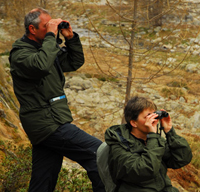Continuing our new weekly selection of the very best titles available through NHBS:
Animal Migration: A Synthesis
Edited by EJ Milner-Gulland, John M Fryxell and Anthony R E Sinclair
What?
A collection of papers drawing together all the very latest theory and research about animal migration, presented thematically, and suitable for graduate students, and researchers in animal ecology, evolutionary theory, movement biology and conservation biology.
Why?
Animal Migration covers all major migratory groups, broadening the scope of migration studies from its usual bias towards birds. It provides a wide and integrative view of the subject, bringing into consideration the most recent developments in the ecological and evolutionary sciences, including technological improvements in computer modelling and tracking systems.
Who?
E.J. Milner-Gulland studied Pure and Applied Biology at Oxford University, and then did a PhD in resource management at Imperial College London. She later became a Reader and then Professor in Conservation Science, also at Imperial College London. Her current research interests concern the interaction between human decision-making and the dynamics of exploited populations, as well as the ecology and conservation of the migratory saiga antelope in Central Asia.
John Fryxell obtained both his undergraduate and graduate degrees from the University of British Columbia. His PhD research was on the ecology of the white-eared kob – a migratory antelope in the southern Sudan. He held a lectureship at the University of British Columbia and briefly worked with the Government of Newfoundland before assuming a faculty position at the University of Guelph, where he is currently a Professor in the Department of Integrative Biology.
Anthony Sinclair has conducted research in Serengeti, Tanzania, since 1965, mainly on the problem of what determines the size of animal populations, particularly vertebrates, and the mechanisms of regulation. This work has expanded to look at the whole ecosystem, documenting how the different components of soils, plants, herbivores and predators interact.












 already adopted Paramo for work and leisure including cameramen and sound recordists such as
already adopted Paramo for work and leisure including cameramen and sound recordists such as 










